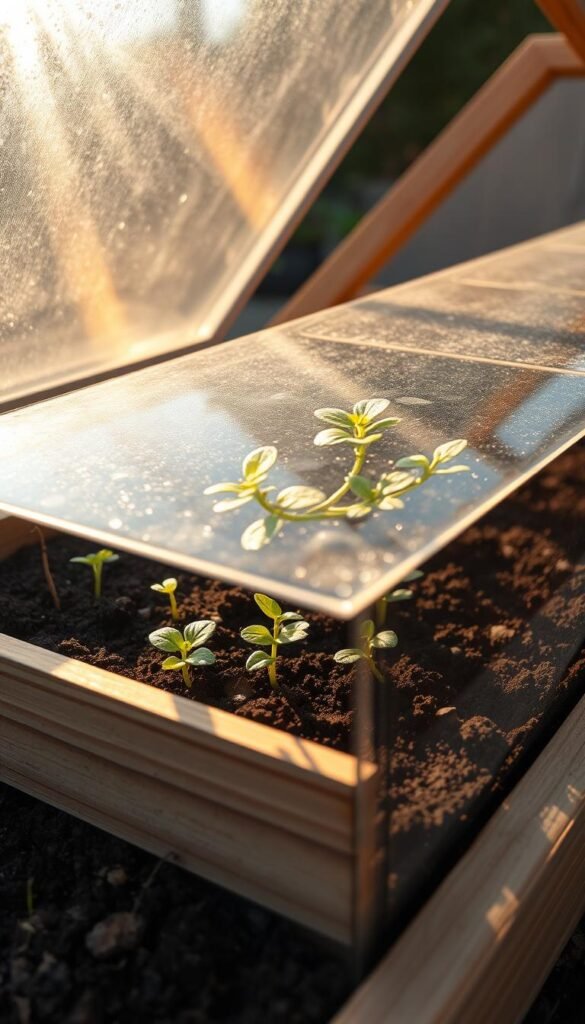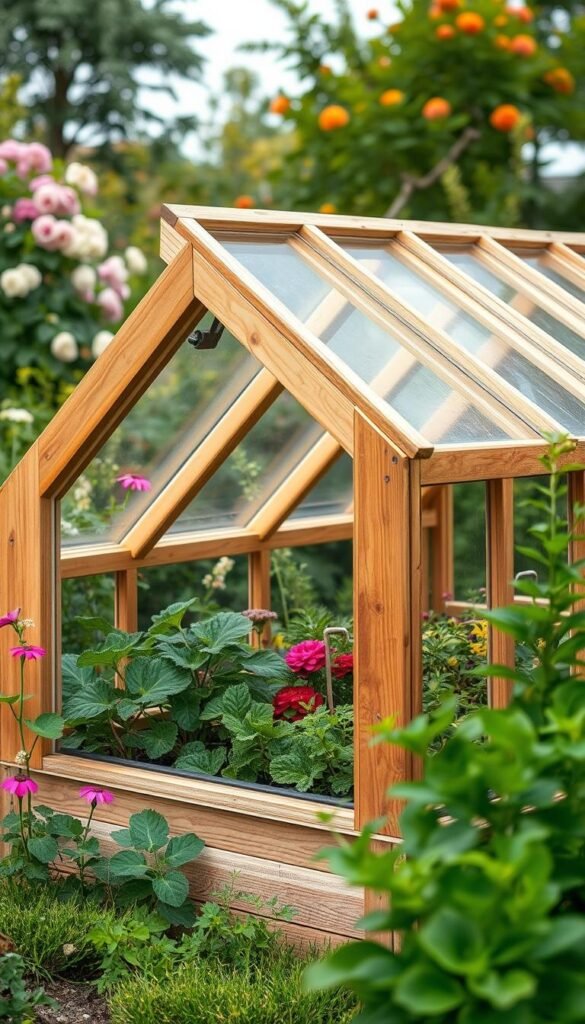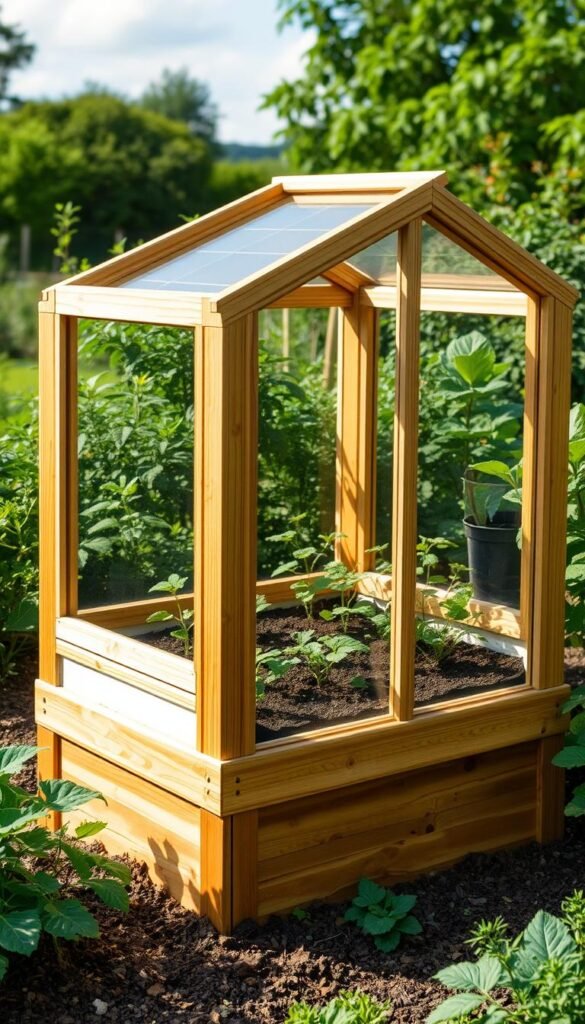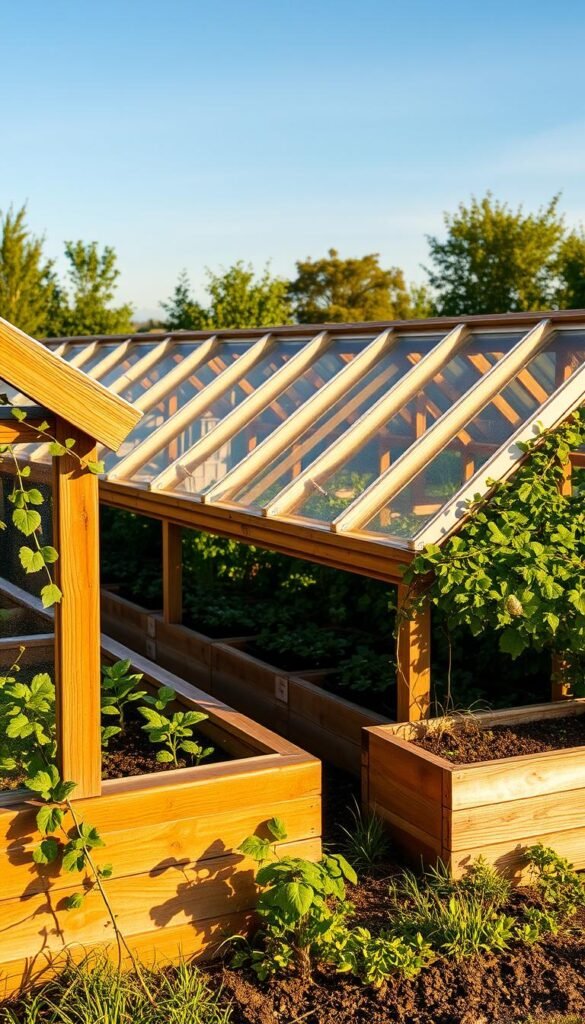Want fresh veggies even when temperatures drop? Cold frames offer a simple, budget-friendly way to stretch your garden’s productivity. These handy structures trap warmth, letting you grow tender crops longer and shield hardy plants from frost.
In places like Minnesota, where the growing season runs just May through September, every extra week counts. With a cold frame, you can harvest crisp salad greens in winter or start tomatoes weeks earlier. Best of all, they’re far cheaper than greenhouses.
Ready to enjoy homegrown food year-round? Learn how season-extending tools can boost your harvests. Your plants—and plate—will thank you!
What Is a Cold Frame and How Does It Work?

A simple box with a clear lid can transform your winter garden. A cold frame is a bottomless structure with a transparent, angled top. It traps heat and shields plants from harsh weather, acting like a mini greenhouse.
Definition and Basic Principles
These frames rely on sunlight to warm the air inside. The sloped lid (8–12 inches front-to-back) maximizes exposure to low winter sun. At night, trapped heat keeps soil and plants cozy.
How Cold Frames Create a Microclimate
Inside the frame, temperatures stay 1.5 USDA zones warmer. For example, a Maine garden can mimic New Jersey’s climate. This microclimate protects seedlings from wind and frost.
Common lid materials include:
| Material | Pros | Cons |
|---|---|---|
| Polycarbonate | Durable, lightweight | Higher cost |
| Storm Windows | Budget-friendly, recyclable | Heavy, may yellow over time |
Ventilation is key. Open the hinged lid on sunny days to prevent overheating. Close it at night to lock in warmth.
Benefits of Using Cold Frames in Your Garden

Turn chilly months into harvest opportunities with simple garden tools. These structures offer three game-changing perks: more harvest time, tough-weather protection, and a head start for plants.
Longer Harvest Seasons
Enjoy spinach all winter or carrots sweetened by frost. Cold frames add 3+ weeks to tomato and pepper yields. They also ease transitions for kale and leeks from fall to winter.
Protection from Frost and Wind
Special fabrics like GardenQuilt shield crops down to 25°F. Wind stress drops by 50% compared to exposed plants. Delicate greens like mâche avoid freeze-thaw damage.
Early Starts for Seedlings
Sow seeds 4–6 weeks earlier than outdoor planting. The trapped heat mimics warmer zones, letting you cheat spring’s unpredictability.
“A cold frame is like a time machine for your garden,”
says a Vermont grower.
How to Build a Cold Frame: Materials and Design

Building your own cold frame unlocks fresh harvests even in frosty weather. Whether you repurpose old windows or buy new materials, the right design traps heat and shields plants. Here’s how to create a sturdy, efficient structure.
Choosing the Right Materials
Durability matters for outdoor use. Rot-resistant cedar lasts longer than pine but costs more. For lids, UV-stable polycarbonate outperforms glass in hail-prone areas. Compare options:
| Material | Best For | Lifespan |
|---|---|---|
| Cedar Wood | DIY frames, snowy climates | 10+ years |
| Recycled Windows | Budget builds | 5–7 years |
| Polycarbonate | Pre-made frames | 8+ years |
Optimal Size and Slope
A 4×4 ft box fits most garden beds. Angle the lid 10–15° (taller at the back) to maximize sun exposure. This slope sheds rain and snow easily.
“My cedar frame with a polycarbonate lid survived three Minnesota winters—no cracks!”
DIY vs. Pre-Made Options
Handy with tools? A 2×2 lumber frame costs under $50. Pre-made polycarbonate frames run ~$200 but include vents. For automation, add Univent arms ($35) to self-regulate heat.
Best Plants for Cold Frame Gardening

Transform your garden into a year-round buffet with the right plant picks. Cold frames let you grow everything from frost-hardy vegetables to tender summer crops. Match your choices to the season, and you’ll harvest fresh flavors even in winter.
Cold-Tolerant Champions
Some plants thrive in chilly weather. Spinach and carrots sweeten after frost, while mâche survives -10°F—harvest it frozen! August-sown carrots become “candy carrots” by winter.
Top picks for cold frames:
- Spinach: ‘Winter Bloomsdale’ resists bolting.
- Carrots: ‘Napoli’ grows fast for fall planting.
- Mâche: ‘Vit’ thrives under snow cover.
Heat-Lovers with Extra Protection
Tomatoes and peppers need warmth. Use black plastic mulch to boost soil temps by 5°F. Water walls around fall tomato plants shield them from early frosts.
| Plant | Cold Frame Tips | Harvest Window |
|---|---|---|
| Peppers | Plant in July; mulch for root heat. | Late Sept–Oct |
| Tomatoes | Use water walls for frost protection. | Oct–Nov |
Salad Greens All Year
Mix claytonia, minutina, and ‘Biondissima Trieste’ chicory for winter salads. Sow scallions by mid-July for winter pulls. Rotate crops: radishes → basil → spinach for continuous harvests.
“A well-stocked cold frame is like a grocery store in your backyard,”
Setting Up Your Cold Frame for Success

Give your plants the perfect home with smart cold frame placement. A little planning ensures they get enough sun, warmth, and moisture to thrive. Follow these steps to create an ideal microclimate.
Ideal Location and Sun Exposure
Face your frame south for maximum light. Aim for 6+ hours of daily sun, especially in winter. Avoid shady spots near trees or buildings.
Slope the lid slightly to shed rain and snow. This angle also helps capture low winter sunlight. A 10–15° tilt works best for most garden setups.
Soil Preparation and Mulch Tips
Mix compost into the soil before planting. It retains nutrients and improves drainage. For extra warmth, lay black plastic mulch—it raises soil temps by 5°F.
Use straw mulch over root crops like carrots. It prevents frost heaving and keeps them snug. Remove winter mulch in spring to let the soil warm faster.
Watering and Ventilation Basics
Install drip irrigation under plastic mulch. It keeps water steady without overwatering. Check moisture weekly—dry soil harms roots faster in confined spaces.
Ventilate daily when temps hit 60°F. Prop the lid open 2–3 inches to avoid scorching plants. Close it at dusk to trap heat overnight.
“A well-placed frame with good soil is like a cozy blanket for your greens,”
Managing Temperature and Ventilation
Keeping your plants cozy yet cool requires smart temperature control. Too much heat cooks them; too little stunts growth. With simple tricks, you’ll maintain the perfect microclimate.
Timing Lid Adjustments
Open the lid when temperatures hit 60°F—even in winter. Partially lift it 4-6 inches for gentle airflow. Close it two hours before sunset to trap residual heat.
Use a min/max thermometer inside the frame. Ideal ranges:
- Day: 65-75°F (perfect for greens)
- Night: 35-45°F (protects from frost)
Automatic Venting Arms
Univent arms ($35) auto-open lids at 68°F. They use wax cylinders that expand with heat. No electricity needed—just set and forget.
These work best for:
- Weekend gardeners
- Heat-sensitive plants like lettuce
- Sloped frames (10-15° angle)
Preventing Sunny Day Overheating
Whitewash lids in summer to reflect 30% of light. For emergencies, prop wood blocks under the lid during heat waves. Below 10°F, add reflective insulated covers.
| Method | Temp Control | Best For |
|---|---|---|
| Manual Venting | ±5°F accuracy | Small frames, daily monitoring |
| Auto Vents | ±2°F accuracy | Larger setups, busy gardeners |
“I lost a batch of spinach by forgetting to vent on a 70°F day—now I swear by automatic arms,”
says a Colorado urban farmer.
Seasonal Adjustments for Spring and Fall
Adapt your cold frame strategy as the weather shifts for non-stop harvests. A few tweaks protect plants from extreme temps and extend your garden’s productivity. Here’s how to transition smoothly between seasons.
Transitioning Plants in Early Spring
Gradually harden off seedlings over 7–10 days. Open the lid for longer periods each day to acclimate plants to outdoor temperatures. This prevents shock when transplanting.
Rotate covers: swap heavy winter quilts for lightweight garden fabric. It balances warmth and airflow as spring days warm up.
Extending Harvests Into Winter
Sow cold-hardy crops like mâche in September. Its leaves sweeten after frost, perfect for winter salads. Harvest scallions frozen—they’ll thaw crisp and fresh.
Add straw bales around the frame’s edges for extra insulation. In Zone 3, pair with low tunnels for double protection.
Snow and Insulation Management
A 6″ snow layer acts as natural insulation. Brush off heavy, wet snow to prevent lid damage. Reflective covers boost warmth below 10°F.
| Season | Adjustment | Benefit |
|---|---|---|
| Spring | Vent lids daily | Prevents overheating |
| Fall | Add straw mulch | Retains soil heat |
“Stagger planting dates and covers—your frame can yield food 10 months a year,”
advises a Michigan grower.
Enjoy Fresh Produce Year-Round With Cold Frames
Fresh veggies in February? It’s possible with the right setup. Cold frames turn your three-season garden into a year-round powerhouse. Even in Maine, growers harvest spinach and mâche under snow—proof that plants thrive with simple protection.
Start small with a 3×4 ft bed for salad greens. Pair frames with row covers or windbreak netting for extra frost defense. These tools buy you time, letting tender crops outlast freezing temps.
Ready to enjoy homegrown fresh produce every month? Build or buy a frame before fall’s first frost. Your future self will thank you when winter meals come straight from the garden.






